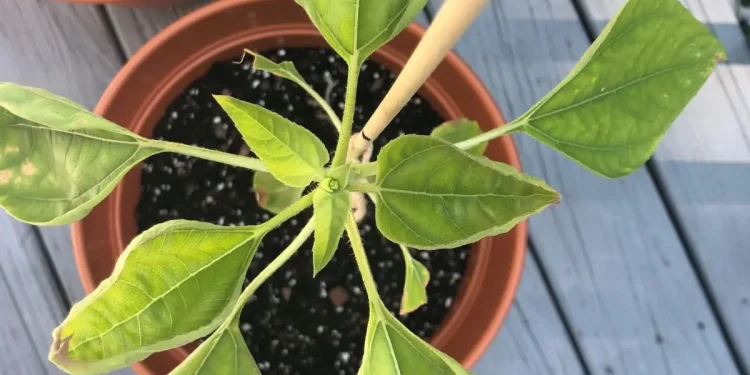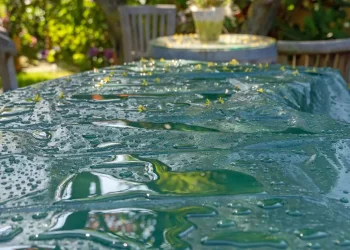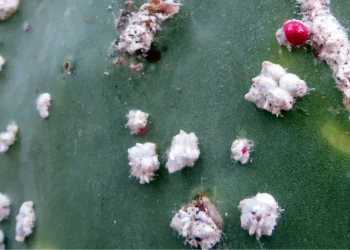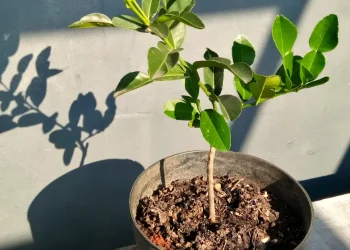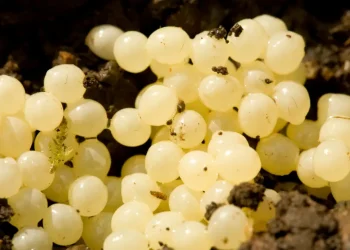I’ve always loved sunflowers, so I got myself one. It was growing proudly upward and looked really healthy. But then, one day, I noticed something that gave me a bit of concern – the leaves started to curl. And not just a bit, all the way to the stem both inwards and outwards. I wondered if my sunflower was trying to tell me something or if it was just a natural part of its growth.
It turned out my watering wasn’t completely on point, and the sunflower wasn’t getting enough water it needed during hot summer days. Through mistakes, one learns.
In this article, I’ll share how not to make the same mistakes as I did, as we’ll take a closer look at why your sunflower leaves are curling and how to fix it. There’re many underlying issues that may be going on, so take on your favorite gardening gloves and let’s dive in!
Why are my Sunflower Leaves Curling?
Sunflower leaves may curl due to various factors, such as environmental conditions, pest infestations, and inherent sunflower characteristics. You can get a lot of information about the cause from the direction of the curl. If it’s inwards, it might indicate underwatering or inadequate water absorption. Conversely, downward curling could be a sign of overwatering.
But this simple trick doesn’t work at all times. Although overwatering or underwatering is the most common cause for sunflower leaves to curl, when it’s caused by a pest or fungus, adjusting the watering schedule won’t do much. Similarly, it can also be caused by a temperature shock, which is something you can’t control very well.
Let’s now go into more detail about each of the potential causes and how to fix the.
Too Much Water
Overwatering is a common issue that can lead to sunflower leaves curling.
They do need a lot of water due to their rapid growth. A sunflower can grow from a seed to a mature plant in just 2 months, averaging extra 6 inches (15 centimeters) a week. That’s in ideal conditions, which includes plenty of water – around 2 gallons (2.5 liters) per week.
As a sunflower grows that extremely fast, many gardeners have the need to water it constantly. With that, their root systems may become waterlogged, impeding proper oxygen intake and causing stress. And under all that excess water weight, you might notice the leaves curling downwards.
To confirm if overwatering is the culprit, check the soil moisture level with your finger. If it feels consistently damp or drenched, you might be overdoing it.
To fix the problem, allow the soil to dry out between watering sessions. Be sure to water the sunflower deeply and less frequently, allowing their roots to breathe. It’s a lot better for the plant to water heavily in one session than to divide it into many.
In borderline cases, root rot may have already taken over your sunflower. If the roots are discolored and mushy on touch, that’s the case and you should replant it to a new, fresh soil.
Underwatering
When sunflowers don’t receive enough water, they become stressed, and their leaves may curl upwards in an attempt to retain water. If you notice the leaves looking parched, dull, or wilting, it could be a sign of inadequate water supply.
To address this issue, simply add one extra weekly watering. Be mindful not to flood the plant with water. The soil should be moist, not soggy.
Moreover, it’s also important to make sure there’s enough humidity around your sunflower. Although the plant can be properly watered, the leaves may still curl as a way to conserve moisture when the air is too dry. To increase humidity, you can mist your plant regularly.
Temperature Shock
Temperature fluctuations can also lead to sunflower leaves curling. Sunflowers are hardy plants, but sudden and extreme changes in temperature can cause stress, affecting their leaf health.
If your sunflower experiences temperature shock, you may notice the leaves curling as a protective mechanism. Usually inwards when there’s cold or a draft as a way to conserve heat, or downwards when the temperature rises too quickly to enlarge the leaf surface and prevent overheating.
To prevent temperature shock, be mindful of the weather conditions and avoid exposing your sunflowers to drastic temperature changes. If you plan to move your sunflower from indoors to outdoors or vice versa, do so gradually over several days, allowing the plant to adjust to the new conditions. Additionally, provide some protection during colder nights with a light cover or bring potted sunflowers indoors when temperatures drop significantly.
Transplanting Shock
When you move a sunflower from its original location to a new spot, it can experience stress and shock as it adjusts to the change in environment. This transition can disrupt the plant’s root system and lead to curling leaves as a visible sign of distress.
To minimize transplanting shock, it’s crucial to handle the sunflower’s roots with care during the process. Be gentle when removing it from its original location, and try to keep the root ball intact. Before replanting, ensure the new spot has the appropriate soil type, sunlight, and drainage conditions for the sunflower to thrive. Water the transplanted sunflower well and provide some shade for the first few days to reduce stress.
Pest Infestation or Fungus
When your sunflower gets infested by pests or catches a fungus, you should see the leaves curling as an important indicator. As the leaves are quite sensitive, they can give away pests or fungi relatively fast.
Insects such as aphids, thrips, or mites can feed on sunflower leaves, causing damage and triggering curling as a defense mechanism. Additionally, fungal diseases like powdery mildew or downy mildew can affect sunflowers, leading to leaf curling, yellowing, or spotting.
With both of these, it’s important to act fast. Although it’s not the most gentle solution, I’m always quick to reach for insecticide, as pests can easily attack your other plants. Fungus can quickly spread, too, so practice good garden hygiene by removing and disposing of infected leaves.
Mineral Deficiency
If you plant your sunflower into a pot with good soil, this should not be an issue. However, gardening soil is usually not very rich and nutrients, so a sunflower planted in a garden without using any additional fertilizers can miss some essential nutrients and minerals. That’s also the reason why you shouldn’t use garden soil in pots.
Nitrogen deficiency can cause overall stunted growth and yellowing of leaves, while potassium deficiency can lead to weakened stems and leaf curling. Likewise, magnesium deficiency can result in interveinal yellowing and curling of leaves.
Conducting a soil test is a great way to make sure your sunflower is not missing anything. You can get a testing kit very cheaply in any gardening store.
Conclusion
The most common causes of sunflower leaves to curl are overwatering and underwatering. When a sunflower receives too much water, it tries will curl downwards under all that heavy water weight. On the other hand, inadequate water supply leads to wilting and curling of leaves as the plant becomes stressed.
Temperature shock and transplanting shock can also trigger leaf curling as sunflowers adjust to new environments. And finally, pests or fungal infections are also potential culprits. Although it will probably manifest itself in another way, a more visible one.
If you notice your sunflower leaves curling, examine the plant and its soil. Usually, just a little adjustment is everything needed to get everything back to normal.

